
UPAA Blog 2021-22 #6- 11/18/21
Photo and video are unavoidably equipment-intensive jobs. Sometimes we can get caught up in the hopes that a new gadget can be the key to a creative breakthrough or solve the frustration of the month. Any photographer who's been at this profession a while has that drawer or box full of gadgets and gizmos that seemed to make life easier for a while, but didn't quite work out as hoped, or got superseded by a gadget that made life even easier for half the price. And let's be honest, every manufacturer has their share of letdowns and lemons as well. No brand is immune.
Here are five stories of UPAA members who've made gear purchases that didn't turn out as hoped. None of these are meant to impugn any brand or company (most of these items are discontinued anyway) but are simply memories and lessons worth reminding ourselves of from time to time.
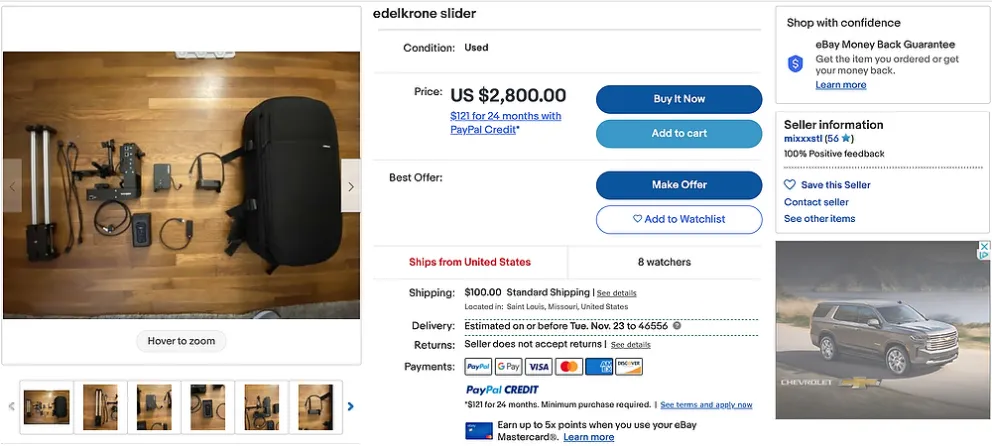
Above, a screenshot from an Edelkrone slider bundle for sale on eBay. Unknown if it's the same model, though.
Edelkrone Slider -"I don't think we got a single good hyper lapse from it."
By Brianne Lehan, Lead Videographer, University of Florida
A couple years ago we bought one of the larger Edelkrone Sliders – I don’t even think the model exists anymore. (The link to what we had seems to be broken on their website if that is any indication of how it performed.) We must have been one of the first to get this particular system because about a month later they sent us a new focus/slider mount piece for free noting that the original was not as good.
For those unfamiliar with this product, it is a large set of slider rails that you mount a camera on and there is a focus pulling system attached as well. In theory it does amazing hyper-lapses because you can set focal points and the length of time between the points.
Some of the new small versions look promising, but there were so many issues with the one we had I can’t imagine ever wanting to go down this route again. The most obnoxious part about this whole set up was that you had to calibrate the focus of every lens you wanted to use with it and then that calibration data would be stored on your phone’s Edelkrone App. Well… if you don’t have an office phone that means that every person on the team who wants to use it would need to calibrate the lenses for themselves as well.
Calibrating was time consuming and not always perfect. Even when we did get an office phone it wasn’t worth it. The App never seemed to work properly, which rendered the slider useless. In theory it was very cool that you could have this big rail system that could rack focus and do custom hyper-lapses but in reality it was simply an over priced, heavy, bulky, faulty system. I don’t think we got a single good hyper-lapse from it.
We now have a Rhino slider and it is 10x easier, lighter, hassle free, and helps us produce exactly what we had hoped to produce with the Edelkrone. Knock on wood, nothing faulty yet.
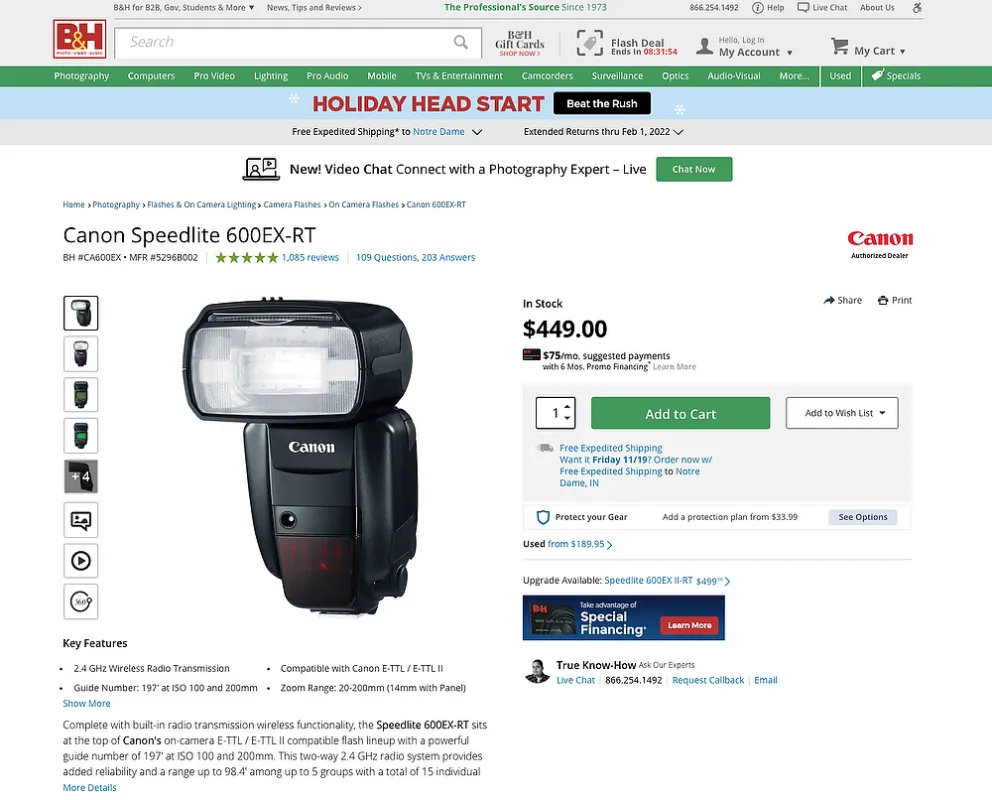
Above, the 600EX-RT still available on the B&H website
Canon 600EX-RT Flash -"I ended up getting like 25 cents on the dollar when I traded them."
By Ken Bennett, Director of Photography, Wake Forest
Several years ago when the new Canon 600EX-RT flash units came out, I was super excited. They had internal radio controls - no more external radio triggers like those kludge Pocket Wizard TTL units, and no more built-in infrared triggers that only worked line-of-sight (and often not even then.)
I bought 4 of them with university funds. $650 each.
On my first shoot, an outdoor portrait, they worked perfectly. Easy to set up, east to control, heck they even worked on TTL. I got a very nice f/1.2 portrait outdoors at some ridiculous shutter speed and it was perfectly exposed.
My second shoot was indoors. (Cue theme from Jaws.)
The flash units went crazy. They wouldn't fire, or they fired constantly without me touching the shutter button. I called CPS and they said that wi-fi interfered with the radio control system, so I should avoid using the flash units in places where there was wi-fi.
I ended up getting like 25 cents on the dollar when I traded them for some Godox gear.
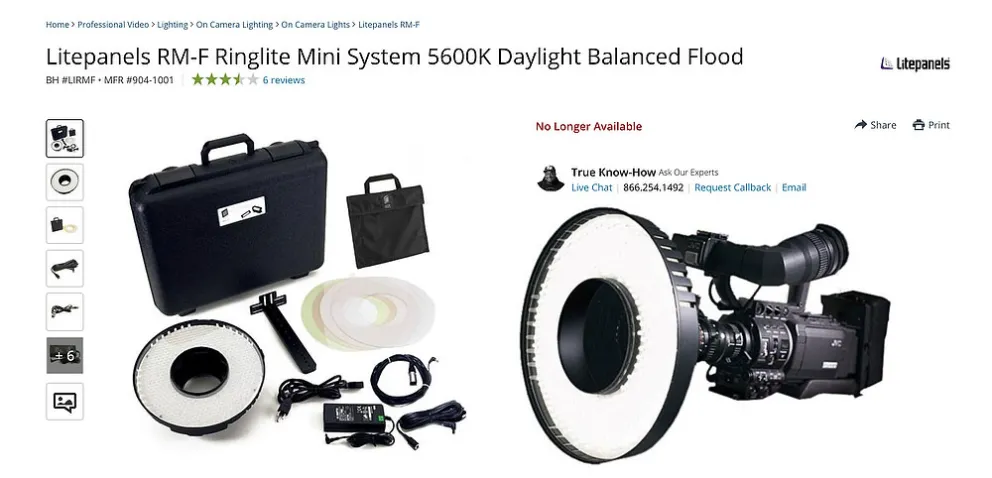
B&H website shows the RM-F Ringlite as "No Longer Available."
Litepanels RM-F Ringlite -"Today it sits on the bottom shelf of our storeroom."
By Jeff Carrion, Assistant Director of Visual Communications, DePaul University
The Litepanels RM-F Ringlingt Mini System was supposed to launch our video production prowess to dazzling new heights, with cinema-like production quality never seen before by a mid-sized private, urban Catholic university. In 2013 we had money to burn so it was a toy we could afford.
Inspired by a Drake video, the lens-mounted ringlight promised to provide an entirely new look to our traditional and stale 3-light interview setup. The interviewee would look directly into the camera, connecting intimately with the audience, with bright highlights on their cheekbones, and a modern-looking falloff and vignette at the corners, while erasing wrinkles better than Lightroom 5.0. There was just one problem.
Having your interviewee stare directly into a light is a bad idea.
It only occurred to me after-the-fact that Drake wore dark sunglasses in his videos. In order to use the ringlight in the way we intended, it had to be dimmed to the point that it was almost completely ineffective as a key light, forcing us to either crank up the ISO, or add more off-axis lights to obtain an exposure, which of course, all but eliminated the effect of the ringlight. What’s more, with a tedious and clunky mount, at best it was impractical and frustrating to mount to a light stand and use as a regular light.
We used it a handful of times for b-roll and off-axis second-camera shots but never as it was envisioned. Today it sits in its case, on the bottom shelf of our storeroom along with our GoPro automotive suction cup mount (still in its original packaging) and Matrox MXO Mini (with its PCI-express adapter). But who knows, the ringlight is having a resurgence, made popular again by selfie-style YouTubers and Zoom-Chic. We may pull it out again for the first time since 2013, along with some FroYo and the Harlem Shake!
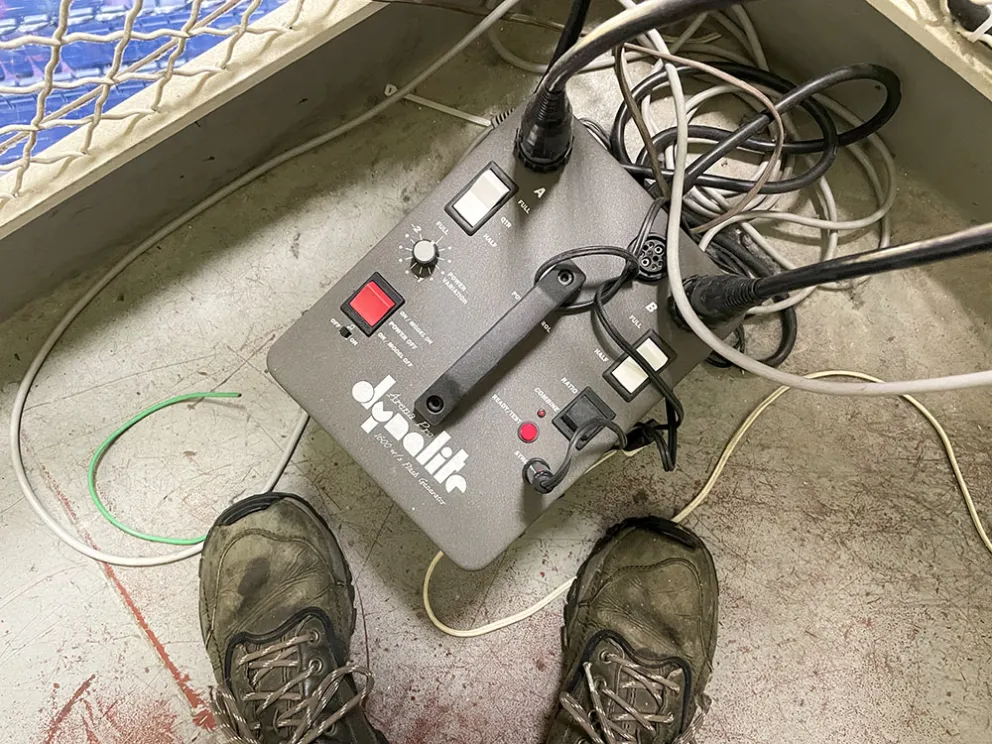
(photo by Matt Cashore) Fortunately, when capacitors go 'boom' it's a good bit of noise but no fire or explode-y bits.
Dyna Lite AP1600 power packs -"Dyna Lite? More like Dyna-MITE."
By Matt Cashore, Senior University Photographer, University of Notre Dame
I'd been using Dyna Lite packs and heads (M2000e packs and 4080SP bi-tube heads) for my arena lighting for many years. The packs were like tanks. I'd send 'em in periodically for service checks and they never needed anything besides a good dusting of the internals.
As digital cameras got more and more dynamic range and Notre Dame installed brighter LEDs in their arenas, I started to notice more motion blur in my strobed action photos. I thought faster flash duration would help and as if on cue, Dyna Lite released the AP1600 series of power packs, specifically designed for action-freezing fast flash duration in large arenas. I sold my seemingly indestructible M2000e packs and bought four AP1600 packs.
BOOM!
The very first trigger of the very first pack out of the box blew a capacitor. Dyna Lite? More like Dyna-MITE. I must underline twice, though, that Dyna Lite's customer service was nothing short of outstanding (more on that in a sec...) but the problem was not a random one-off. Over the next couple of years every one of the AP1600 packs had some or another catastrophic failure, usually announcing itself with a shotgun blast-like sound right in the middle of a packed basketball game.
All that trouble and I didn't notice any improvement in flash duration. Maybe you could measure some micro-improvement with some instrument but to my perception I still saw just as much motion blur as I did with my old packs.
Again, though, Dyna Lite couldn't have been more outstanding in trying to help me. CEO Peter Poremba personally came to Notre Dame with replacement packs and even comped me a couple of new heads. But the problems persist to this day. Even though Dyna Lite is no longer in business there is still fortunately a source for repairs.
I wish I'd never sold my M2000e packs.
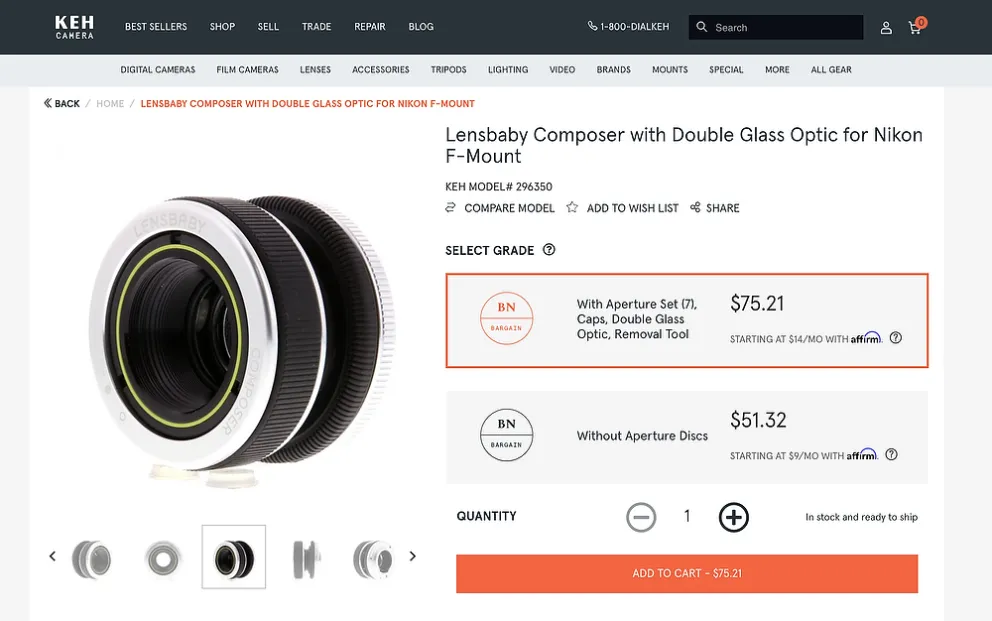
KEH website lists a bargain condition Lensbaby Composer for $75.
Lensbaby -"I attached it to my camera & that is where the challenges began."
By Laura Lyon, Staff Photographer, University of South Florida
I was but a young, impressionable photo sprout in the fall of 2008 when I first saw an advertisement for a ‘Lensbaby’. It sounded so exciting at first…a lens that moved in all directions! That wasn’t attached to a large format behemoth camera! And more affordable than all the other pieces of gear I had set my heart on…I believe they were about $200. For Christmas that year, I asked all relatives who were planning on gifting me something to provide funding towards the coveted ‘Composer’, the mid-level Lensbaby attachment. I was determined to build an explosive portfolio of images like the ones I saw on the Lensbaby website. This was my ticket out! And as a ‘thank you’ to all who supported my journey, I was going to handwrite a letter of thanks & include a series of knock-your-socks-off imagery that could only be created by the union of my prodigious artistic eye and this hidden gem piece of equipment.
It arrived on my doorstep in a precious little box. I attached it to my camera & that is where the challenges began. It didn’t move around in a silky motion like in the videos I had seen. In fact, you had to be very careful because it would barely adjust and if you made too much of an effort to move it, the entire sharpened focal point would shift completely. Even though I had plenty of experience with manual focus, most of my images were completely out of focus.
Too much time was passing with very little progress. I picked 3 of the ‘least worst of’ images to print & wrote a note telling my aunts & uncles that I bought the lens, I shoot with it all the time & have encountered a bit of a learning curve. I ended saying I would send updates soon and then immediately tossed the thing back in the box (because you always save the box!) Years later I fished it out of a long forgotten gear bag and I think I managed to get $30 or $40 bucks for it on Ebay. Those early trial images did not survive years of archive culling.
_______________________________________________
"I regret rubbing ketchup in my eyes. I can say that with Heinz sight." Got an article, idea or just a better joke to contribute to the blog? Email editor Matt Cashore, mcashore@nd.edu. Follow UPAA on Instagram, too!